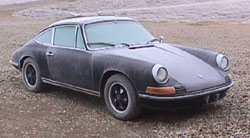A hell of a lot of money,
and no collector value at all...

Click on the car I found to see pictures of how it looks today!
What also appealed to me about the car was that it had sat in the sun, oxidizing, for such a long, long time that, now, repainting it wasn't an option -- it was a necessity. But because it was a necessity, I could get it to look the way I wanted an early 911 to look without having to trash an already passable exterior. I ordered flared fenders and an RS-style rear bumper from Rennspeed Motorsports, and also got a (non-stock) fiberglass panel to cover up the flat (stock) rear license panel (that seemed -- to me -- to be out of step with the 911 rear end's overall lines).
So I had the painting done, and had the look I wanted with most of the mechanical work already taken care of. Great, right? Well, 'most of the work' isn't the whole car. The previous owner had run out of money before he got to working on the brakes or transmission. I bought it knowing that both of these areas would need serious (and possibly expensive) attention.
Sure enough, my first stop after picking the car up in Illinois revealed trouble. My brother is an engineer who designs transmissions for Daimler-Chrysler in Indiana. He and I got under the car to drain the old gear oil, with the intent of putting new oil in for the next 300 miles, then draining it again, and replacing it with Swepco 201.
About a cup and a half of black goo dribbled out of the bottom of the 915 tranny. A disconcerting find. The transmission had a little bit of trouble in the first-to-second synchro, but it also appeared to have suffered some significant abuse (who knows how many years on that same change of gear oil?),
Still, we refilled it, and he guessed it would be able to make the 2,300 mile drive back to Los Angeles. The brakes were also functional (although not perfect). A friend of mine and I had flown out to drive the car back (my girlfriend declined the offer to spend four days with me in an un-air-conditioned car the size of a VW bug) and a cursory look at the car indicated that it would probably make it.
Well, always think twice before you set out on a 2,300 mile first drive of a 27-year-old car. Five hours into the drive, the alternator went. That led to two days in St. Louis, while parts were flown in from California. Having joined the PCA that week turned out to be a good move, as the local chapter president pointed us to a place that could work on early 911s.
Back on the road, we relied on the radar detector , cranked up the Car Audio Innovations stereo, and made up for lost time. We covered about a thousand miles that day, But the following day, at the border of New Mexico and Arizona, the electrical problems resurfaced, though, and the car just stopped. We later learned that the wire that connects the starter motor to the battery had been held in place with some curtain string (not the tabs that are designed for it) and when that string gave out, the wire fell and started rubbing against the rear right axle. It may or may not have been the reason the alternator failed, but it was certainly the reason we were stuck at 8:30 on a Friday night in a town where Porsche's were unheard of, and where -- according to the Chevy-loyal tow truck driver -- even a Dodge was considered an exotic and suspicious means of transportation.
At night in the desert, you can't do much troubleshooting, so we... decided to call it a trip. We rented a car to get to Phoenix, and put the car on a truck bound for Los Angeles.
And that's where, for the next two weeks, the 911 was gone over, head to toe, by my local Porsche mechanic, Robert Brumley, at L.A. Meister. The 915 gearbox is now rebuilt, and the brakes, brake lines, master cylinder, fuel lines and a host of other components have ether been rebuilt or replaced. I've also gotten the car new chrome (and aluminum, and stainless, and rubber) trim all around (although you might note some of the window trim not yet installed in some of these pictures), including those cool S-style rocker covers that the 73s had. It's also got a new European turbo (non-airbag) steering wheel, and I'm also adding a center console and a new leather-and-vinyl interior.
And that's the story (and the cost) of ownership,
so far. On the plus side, I recently had my first PCA Drivers' Education
event at Willow Springs. All the nuisance of owning a 27-year-old
car, all the cost of getting that car into shape --
all of that disappears when you're on the track,
going hard into a turn at 80 miles an hour.
Mechanical Changes
What's been done, and what's going to happen...Bodywork Changes
The T, fortunately, is no collector car. This is good, since the one part of the early 911 that I didn't love was the rear end.

